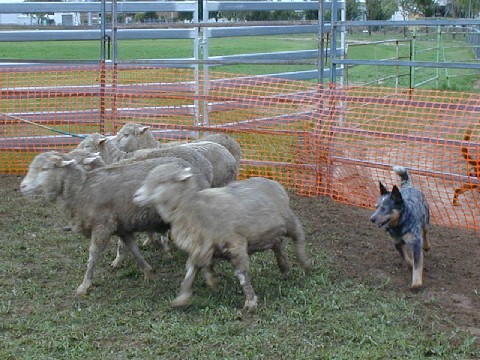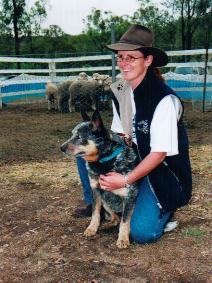The Australian Cattle Dog is an independent thinker and once trained, is capable of carrying out routine tasks without supervision. They are highly intelligent, making them self directed workers capable of complex problem solving. They are adept at picking out and punishing touble makers, while at the same time they can be gentle with calves, lambs or ducks. It is this rating ability that makes the Australian Cattle Dog versatile enough for different classes of cattle as well as trial or farm work with sheep, pigs or poultry.
The Australain Cattle Dog is considered an upright breed. The head is carried at shoulder level while working, enabling the dog to read the stock and to easlity slip in and heel. When confronting stubborn animals at the head, some indivials drop to a crouch, preparing to nose bite, while others raise their heads to challenge and come straight on. Most dogs will experiment with different postures or approaches to win stand-offs with stubborn stock. The Cattle Dog's perfect combination of size, angulation, balance, agility and instinct enables him to continuously heel low and avoid being kicked.
The Australian Cattle Dog's approach to stock is calculated and deliberate, and directed at the animal or animals to be moved. He naturally wears on larger groups of stock, but can walk straight in at the balance point or singles or smaller groups of cattle or sheep. Whether an individual dog predominatley fetches or drives is due not only to heritage, but can be affected by the dog's age, training technique, and the livestock the dog is started on. Cattle Dogs that fetch usually exhibit very keen natural balance. Regardless of individual style, the Australian Cattle Dog is considered a close worker. There is however variation, with some dogs working and flanking very close and others working and flanking moderately wide and closing the distance to heel. Most can be taught to work wider if required.
Australian Cattle Dogs are a loose to medium eyed breed. When heading, turning or toherwise challenging stubborn livestock, some individuals exhibit moderately strong eye, but return to a looser approach once the challenge is won. This loose approach enables the Cattle Dog to see and react to a large herd of cattle and give attention to just those reqyring it, alowing him to work effectively, day in and day out.
The Australian Cattle Dog is best known as a "heeler" because of his instinctive grip. This is done in various ways depending on the livestock and rate of travel. Stubborn or wild stock may require a forceful had biter until trained, whereas dairy cattle may just require a dog's presence. The typical technique is for the dog to time the grip to occur on the foot of the weight bearing leg, and to duck to miss the ensuing kick. The correct "heel" is low on the leg at the fetlock or coronet. The Australian Cattle Dog should not only heel, but use force at the head when turning or stopping livestock. All gripping should be quick with an immediate release. Gripping should be appropriate and not excessive.
The Australian Cattle Dog was developed as a silent worker. Force barking when heading or otherwise challenging stubborn livestock is acceptable if it is not excessive. Continuous barking, barking while working at the heels or more that just a few force barks is undesirable. |

